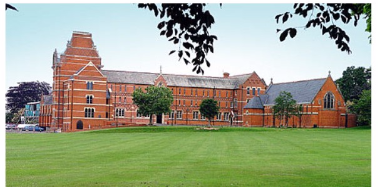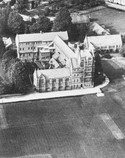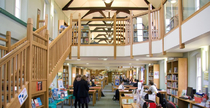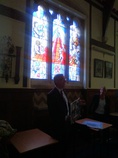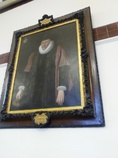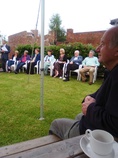
THE HISTORY OF
EXETER SCHOOL
Visit on Thursday, 9 June 2016
The dry spell held for our visit to Exeter School on 9 June. We met Kevin White, the school's Archivist, and John Davidson, Director of Alumni Relations, in the quad and they took us into the chapel, where Kevin gave us a short history of the school.
The original school started with 25 street boys selected at random to be educated and taught a trade – they became "Pinners". There is a painting of Hugh Crossing, who initiated these good works, in the school.
Exeter School, originally the Exeter Free Grammar School, opened in August 1633, occupying the medieval buildings of St John’s Hospital on the south side of the High Street. The school moved to its present site in 1877. The cost for the fields was £7,600 with a further £16,750 spent on the erection of buildings.
It was explained that the chapel was designed by William Butterfield who was responsible for most of the school buildings and who also designed, amongst many other great buildings, Keble College, Oxford. Plaques on the chapel wall commemorated the sad deaths of pupils and staff in various wars, the first being a pupil in the Boer War, and also the passing of long-serving members of staff and Governors.
We returned to the quad to admire the various additions to the sports hall which are in keeping with the architectural style of the school. Nearby is a new indoor swimming pool under construction, funded by an anonymous benefactor. Notwithstanding the warm evening sunlight, we all shivered as Kevin talked about the old days and the desperate cold of outdoor swimming at the school.
To our right were the school fields and Lower Meadow (beyond the big tree in this photograph). An area of woodland and scrub at the southern end of this land is now the location of the Nuffield Hospital and its car park but in the 1940s and 1950s it was a favourite apple-scrumping area for pupils, and occasionally a place for a quiet and illegal smoke. There is very large grassed area for every type of sport. In Kevin's time it was a rugby playing school and football was not allowed. Today, the scooloffers a wide range of sports for both boys and girls.
Within the grounds and adjoining Barrack Road can just be seen the original school sanatorium where boarders who were ill could be accommodated and treated. This later became the Music School. In the 1970s it housed the design and technology department before being converted into a residential property for school staff.
The main school buildings are typical of Butterfield, very gothic with what is called streaky bacon brickwork – alternate colours. We admired the tower building (left) which we learnt, to our astonishment, included, straight ahead of us, a comparatively new (2006) extension. However, the clock came from the Old Eastgate by the oriiginal school premises in town. The match to the main building was seamless.
John led us up the stairs and showed us photos of how the top floor dormitories had looked. After the boarding house closed in 1999 the top floor was opened out by removing dormitory partitions and integrating it with the floor below. This created a wonderful library with the whole area flooded with light from the handsomely long windows. Some of the original boarders' study rooms have been kept to show what a Victorian boarding house study would have been like.
The upper level (where the dormitories had been) was now made up of wooden walkways with rows and rows of books. The whole area is flooded with light from the handsomely long windows, which you can just see and which of course lit the original dormitory.
Down the stairs at the other end of the building we came out into the Victorian Fives Court, the only one of several to have been preserved. Fives is an English sport where a ball is propelled against the walls of a special court using a gloved or bare hand as though it were a racquet.
In 1933, Bishop David, an old boy, opened a new 3-storey block now known as the Andrews Wing. This building included classrooms and the original school library - quite rare for a school at that time. This is now one of the school's lecture rooms.
Down the original "lower" corridor are classrooms designed to accommodate 100 boys. There are now 900 students aged 7 to 18 so there are many modern up-to-date buildings which though most elegant were not a part of our remit – the history of the school.
We visited Butterfield Hall which until 1965 was the dining room with a raised dais at one end where staff could eat looking down on the boys. It later became the Junior Library and is now used as a meeting room.
There were some excellent stained glass windows and many paintings including one of the founder of the school, Hugh Crossing, (below right) who was so keen to help those poor boys that he used much of his own money to ensure their success.
Tea and incredibly posh bickies, kindly laid on by Karen Dart who had organised this whole visit so excellently, broke our journey as John led us to sit under a large gazebo on very hallowed ground – until recently only for senior staff but now colonised in fine weather by the Upper Sixth for peaceful study.
We faced the stable building which had once housed a donkey (the stable door with its hayloft hatch above can be seen on the right in the photo). The building has now been converted into a centre for past pupils – Old Exonians - by doubling its size. The extension on the left is virtually indistinguishable from the original building. Within the extension is an elegant board room graced by many pictures, including one of Veitch, while outside are Harry Pennell's memorabilia (Pennell was Scott of the Antarctic’s navigator and then captain of the Terra Nova).
A blue boy statue, one of four in the city, can be seen at the top of the stairs placed as if he is looking out of the large central window.
Upstairs were Kevin’s office and display rooms containing many old records of the school with hand-written registers dating back to the 1880s, a selection of memorabilia and the Detention Book. Upstairs were Kevin’s office and display rooms containing many old records of the school with hand-written registers dating back to the 1880s, a selection of memorabilia and the Detention Book.
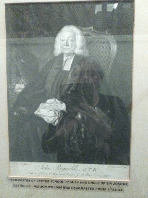 John Reynolds, Headmaster of Exeter School, 1714-34 and uncle of Sir Joshua Reynolds. His son William was Headmaster from 1734-44.
John Reynolds, Headmaster of Exeter School, 1714-34 and uncle of Sir Joshua Reynolds. His son William was Headmaster from 1734-44.
We were told that recently an old boy had written to demand that his name be removed from the Detention Book – this caused much laughter! On the stairs were pictures, in date order, of all the previous headmasters (on the lines of 10 Downing Street!) starting with John Reynolds, headmaster from 1714-1734, and uncle of Sir Joshua.
We were very lucky to be able then to walk around and examine all the historic documents and mementos before giving Kevin and John a round of applause for one of the best talks – even if it turned out to be mainly a walk ! – we had ever had.
